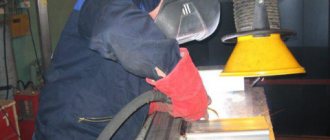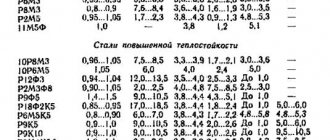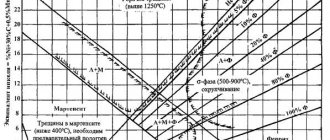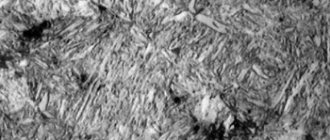Tool steel is an alloy or carbon steel intended for the manufacture of cutting and measuring tools, cold and hot deformation dies, and machine parts that experience increased wear under moderate dynamic loads.
In terms of shape, size and maximum deviations, metal products meet the requirements:
- hot-rolled round steel - GOST 2590-88;
- hot-rolled square steel - GOST 2591-88;
- hot-rolled hexagonal steel - GOST 2879-88;
- forged square and round rods - GOST 1113-88;
- stripes - GOST 103-76, GOST 4405;
- calibrated rods, coils - GOST 7417, GOST 8559, GOST 8560 of h11 and h12 qualifications;
- rods with special surface finishing - GOST 14955 grades h11 and h12.
Advantages and range
Tool steel is one of the most popular materials on the market. The alloy has high hardness and low cost. However, the material also has a drawback - its low wear resistance, so it is not used for the production of machine parts and equipment that are subject to constant loads.
The range of this material is as follows:
- hot rolled squares and circles;
- forged strips, circles and squares.
This is interesting: Carbon steel: composition, classification, GOST
High speed tool steel
High-speed tool steels are distinguished from all the types of tool steel alloys presented above by their higher red resistance. These alloys do not change their mechanical characteristics at temperatures up to 650 ºС. As a result, cutting speed increases by 5 times, and tool life increases by 32 times.
This became possible due to the inclusion of tungsten or its analogue of molybdenum in their chemical composition. Also, the addition of metals such as cobalt, vanadium and chromium to steel has a positive effect on heat resistance. The most popular brands in the mechanical and machine tool industry are R18, R12, R6M4 and R10K5F5. Of this group of tool steels, it is worth noting P12, because it has better manufacturability: it is more amenable to pressure treatment.
Thermal treatment of these steel alloys includes hardening at 1250 ºС and repeated low tempering at 350 ºС. Exceeding the specified temperatures is extremely undesirable, because this leads to a sharp decrease in mechanical characteristics, in particular the formation of brittleness. Sometimes, to improve the corrosion-resistant properties, high-speed cutters are additionally treated with steam.
Read also: The reducer on the gas cylinder is leaking
Tool carbon steel GOST 1435-99
Carbon steel is a steel that does not contain alloying elements, but contains carbon in varying concentrations: up to 0.25% - low-carbon steel, 0.24-0.6% medium-carbon steel, more than 0.6 - high-carbon steel.
GOST 1435-94 regulates the standards for the production of rods and strips forged, hot-rolled, calibrated and with special surface finishing from tool carbon (non-alloy) steel, as well as the standards for the chemical composition for ingots, billets, sheets, strips, wire and other metal products.
Classification of carbon steels
By purpose:
- high-speed - P;
- ball bearing - Ш;
- electrical engineering - E.
By chemical composition:
- quality;
- high quality - A.
By purpose, depending on the mass fraction of chromium, nickel and copper:
- 1 - for all types of products, except patented wire and tape;
- 2 - for patented wire and tape;
- 3 - for products of all types, manufactured with repeated heating, increasing the possibility of steel graphitization, as well as for products that require increased hardenability (except for rolled products for cores, patented wire and strip).
According to the method of further processing:
- a — hot-rolled and forged products for hot forming (upsetting, upsetting), cold drawing;
- b - for cold machining (turning, milling, etc.).
By quality and surface finish:
- for hot-rolled and forged steel: 2GP – for subgroup “a”, 3GP – for subgroup “b”;
- for calibrated steel - B and C.
- for rolled products with special surface treatment - B, D, D.
According to the condition of the material:
- steel without heat treatment;
- heat-treated steel - TO;
- cold-worked rolled products - NG (for calibrated bars and with special surface finishing).
Carbon tool steel grades
Grades of tool carbon steel: U7, U8, U8G, U9, U10, U11, U11A, U12, U13, U13A, U7A, U8A, U8GA, U9A, U10A, U12A.
Designation of steel grade: Y - carbon, the number following it is the average mass fraction of carbon in tenths of a percent, G - increased mass fraction of manganese.
Applications of Carbon Steel Tools
| steel grade | Application area |
| U7(A) | Woodworking tools (axes, chisels, etc.); small pneumatic tools (chisels, crimpers, etc.); forging dies; needle wire; plumbing tools: hammers, sledgehammers, screwdrivers, pliers, wire cutters, etc. |
| U8(A), U8(G, GA), U9(A)) | Tools used in conditions that do not cause heating of the cutting edge and when processing wood: cutters, axes, chisels, saws, etc. Knurling rollers, plates and cores for injection molds of tin-lead alloys. For plumbing tools (rivet presses, punches, screwdrivers, pliers, wire cutters). For profiles of simple shape and lower accuracy classes; cold-rolled strip 0.02-2.5 mm thick. |
| U10A, U12A) | Cores. |
| U10, U10A) | Needle wire. |
| U10(A), U11(A)) | Tools used in conditions that do not cause heating of the cutting edge and when processing wood: hand and machine cross-cutting and carpentry saws, twist drills. For cold stamping dies (drawing, heading, trimming, cutting) of small sizes; for calibers of simple shape and lower accuracy classes; for knurling rollers, files, metalwork scrapers, etc. Files, scrapers, cotton tape 0.02-2.5 mm thick. |
| U12(A)) | Hand taps, files, bench scrapers; dies for cold stamping (edged, die-cut) of small sizes and without cross-sectional transitions; cold heading punches and stamps of small sizes, simple shapes and low accuracy classes. |
| U13(A)) | Tools with reduced wear resistance (without heating the cutting edge): files, razor blades and knives, scalpels, scrapers, engraving tools. |
General information
Steel, the percentage of carbon in which is more than 0.7%, is called tool steel. The phase structure is based on martensite and only in some cases ladyburite.
It is used mainly in mechanical engineering as a material for the production of tools for processing ferrous and non-ferrous alloys.
Tool steel has a number of features compared to structural steel. Among them, the most important are:
- Increased hardness, which is 60-65 units on the Rockwell scale.
- Extra strength. The tensile strength should not be lower than 900 MPa.
- Ability to resist abrasive wear.
- High hardenability – the property of steels to be thermally hardened.
- Red resistance, which characterizes a metal in terms of its ability to maintain its strength characteristics with increasing temperature exposure to it.
Read also: Sharpening a chainsaw chain on a machine video
According to state standards, the following types of tool grades are provided, based on their technological purpose:
- Tool carbon steels GOST 1435-99. Marked with the letter “U” at the beginning of the marking. The number that follows in the designation shows the carbon component: U12, U10, etc. The dimension is taken in hundredths of a percent. The letter “A” may be placed at the end (for example, U10A), which indicates that this tool steel has a reduced number of negative inclusions. In particular, this applies to sulfur and phosphorus, elements responsible for the deterioration of the mechanical properties of the steel alloy.
- Alloyed tool steels GOST 5950-2000. The number at the beginning shows one hundredth of a percent of carbides in steel. If it is absent, the value of this parameter is assumed to be 1%. This is followed by the letter designation of alloying elements with numbers indicating their content in whole fractions of a percent: X, 5ХВГ, 9ХС and so on.
- High-speed tool steels GOST 19265-73. In technical documentation they are marked with the letter “P”. The number behind it indicates the approximate content of tungsten, the basic chemical component for this steel. In addition to it, high-speed cutters can contain cobalt and vanadium. They are also indicated in the marking with the corresponding letters: K and F. The chromium content in all high-speed steels ranges from 3-4%. For this reason, it is not indicated in the labeling.
- Stamped tool steels GOST 1265-74. This type of steel is marked similarly to alloyed steel. Depending on the nature of their application, they can be cold- and hot-formed stamped steels.
Let us now consider each point in more detail.
Technical requirements
Carbon tool steels must meet the following conditions:
- Easy to process with metal-cutting equipment.
- Do not react to elevated temperatures.
- Maintain stability when attached and glued to other parts during processing.
- Good workability when sanding.
- Positively amenable to calcination.
- Maintain plasticity when heated.
- Maintain carbon in the composition and minimize its release.
- Do not cause cracks in the final product.
Types of metal and markings
The division takes place into high-quality and high-quality types. The difference is that high-quality steel contains 0.03% sulfur and 0.035% phosphorus, and high-quality steel contains 0.02% sulfur and 0.03% phosphorus.
According to GOST, the following are allowed to be released:
- U7.
- U8.
- U8G.
- U9.
- H10.
- U11.
- U12.
- U13.
- U7A.
- U8A.
- U8GA.
- U9AYU
- U10A.
- U11A.
- U12A.
- U13A.
Among high-quality instrumental instruments, most often there are those that do not have the letter “A”, because this is related to a high-quality brand. The letter "U" stands for carbon content. The number following it indicates tenths of a percent of the carbon contained in this brand. When the letter “G” is located after the numbers, this means that the alloy contains manganese.
There is a classification into three types:
- Carbon.
- Alloyed.
- High-speed cutting (this also includes stamping).
Marking
Carbon tool steel grades can have both numbers and letters. In most cases, the marking of tool carbon steels at the very beginning has the letter “U”, which indicates the type of metal. The designation of carbon tool steel also has the following features:
- The first numerical designation after the letter indicates in tenths the amount of carbon in relation to the entire composition.
- There is also the letter “A” following the number indicating the concentration of carbon in the composition. It indicates that the carbon tool steel grade is of high quality.
- The letter “P” can be used to designate the group of steel in question. In this case, this designation is followed by a letter that indicates the concentration of tungsten.
- Other alloying substances are also indicated by the corresponding letter, followed by a number to indicate the concentration.
- It is generally accepted that steel and the group under consideration necessarily contain chromium, but its concentration is not more than 4%. If a number is indicated after the corresponding letter designation, then the concentration of this substance is specified.
You can also find markings for tool carbon steels starting with a number. Let us give an example of the common alloys 9Х or 6ХГВ. The first number also indicates the concentration in the carbon composition, the following letters indicate alloying elements. If a number is not indicated after the letter of the alloying element, then it is generally accepted that their concentration is 1%. In addition, the marking itself may begin with letter designations characteristic of the alloying elements - this indicates that the concentration.
Classification
All brands for production are divided into the following groups:
heat-resistant and tough - usually these are hypereutectoid and hypoeutectoid steels, including chromium, molybdenum and tungsten. Carbon in steels should correspond to low and medium values;- highly hard and viscous, as well as non-heat-resistant - the alloys contain a minimum of alloyed elements, as well as an average amount of carbohydrate, characterized by low hardenability;
- High-hardness and heat-resistant, as well as wear-resistant - these are high-speed alloy steels with a high content of alloyed elements, alloys with a ledeburite structure, which contain more than 3 percent carbon;
- wear-resistant, highly hard with average heat resistance - the materials have a hypereutectoid and ledeburite structure, their composition contains approximately 2-3 percent carbon and 5-12 percent chromium;
- high-quality and high-quality tool steel - differ from each other in the percentage of sulfur and phosphorus present in them;
- highly hard and non-heat resistant - these tool steels with a hypereutectoid structure do not include alloy elements at all, or they are present in minimal quantities. Their level of hardness is ensured by the large amount of carbon in the composition.
The hardness level is a very important parameter for the material in question.
Typically, high-hardness steels are not used for the production of tools that are subject to heavy impact loads during operation. This is due to the fact that these alloys have low viscosity and high fragility, which is why the tool made from them can break. In terms of hardness, these steel materials come with a high level of viscosity, where the carbon content is 0.4-0.7%, or with high wear resistance and hardness, where the amount of carbohydrate is 0.7-1.5%.
Steels also differ in the degree of their hardenability . According to this criterion they are divided into:
- products with increased hardenability, where the hardening diameter is from 80 to 100 mm;
- high - diameter from 50 to 80 mm;
- low - from 10 to 25 mm, respectively.
Alloy tool steel
Compared to the one described above, the alloyed one has a greater thickness of the hardened layer and a lesser tendency to overheat, which can significantly reduce the risk of cracking during heat treatment of the tool. Thanks to this, the minimum overall size of the tool increases from 12 to 40 mm.
Low-alloy steel grades 11X and 13X are recommended for the manufacture of taps, knives and files with a thickness of 1-15 mm. Especially if the specified tool is long.
Steels 9ХС and ХВГС have increased red resistance with a critical temperature of 250 ºС. They are used for drills, dies, dies and other tools with a diameter of up to 80 mm. Their disadvantage is their slight fragility in the annealed state and sensitivity to cracking during grinding.
Also, alloy tool steel has proven itself excellent in the manufacture of various types of measuring instruments - calipers, rulers, staples, etc. - due to the low value of the coefficient of thermal expansion. The most suitable of them were steel types X and XG.
Areas of use
This material has a fairly wide range of applications in industry. They are used in the manufacture of:
cutting tools;- measuring devices;
- casting molds operating under pressure;
- working parts of dies that operate on the principle of hot and cold deformation;
- high-precision products.
Main types
- tool carbon steels;
- alloyed tool steels;
- high-speed.
All of them are produced in accordance with established GOST.
Carbon types of material lose their strength when heated; accordingly, they are used for the production of tools that operate at low speeds or under simple cutting conditions, when the heating temperature is no more than 200 degrees.
They are mainly used for the production of:
- files;
- drill;
- scans;
- taps and more.
Since carbon tool steel has low weldability, it is not used in the manufacture of welded structures.
Depending on the percentage of carbon, manganese, silicon, sulfur and other elements in the material, it is divided into the following grades:
- U7;
- U8;
- U8G;
- U10 and others.
Alloyed materials and their markings
Alloyed materials additionally contain the following elements:
- nickel;
- copper;
- manganese, etc.
All of them improve the characteristics of the material. Alloying elements must be indicated when marking using special symbols and letters. All this allows you to see in advance what a given tool steel consists of. Material brands can also include not only letters, but also numbers. The numbers indicate how much of a particular element is contained in steel as a percentage. If a number is not given when marking, then the amount of the element is about 1 percent.
When marking alloy steel, the first place is taken by the amount of carbon, which is equal to tenths of a percent. For example, grade 6ХС contains carbon in the amount of 0.6%, as well as one percent each of silicon and chromium.
Tool alloy steels are mainly used for the production of stamping or cutting tools, these include:
- dies;
- taps;
- sweeps;
- drill;
- cutters and more.
Like carbon steels, alloy materials are also unsuitable for the production of welded structures.
High speed steels
The marking of high-speed materials consists of the letter “P”, a number indicating the mass fraction of tungsten and the letters of the elements present in the material. This can be cobalt, molybdenum and others. Next come the digital values of their mass fractions. If the marking includes the letters “Ш”, then this means “electroslag remelting”.
The proportion of chromium in high-speed steel is not indicated when marking, and there is also no indication of the mass fraction of molybdenum if it does not exceed one percent.
These types of materials are optimally suited for the production of cutting tools, which, due to friction, are heated to temperatures from 600 to 6500 degrees. At the same time, they will not deform and lose their hardness. This type of product lends itself well to welding using electric butt welding with steel grades such as 45 and 40X.
A few words about labeling
All tool steels have a special alphanumeric designation. According to GOST, this code must be applied to all packages with steel parts, and in some cases the designation must be applied to the part itself. If a part is transported to the territory of another state, marking must be applied. The state standards of the host party must also be taken into account. For example, the state may require that, in addition to domestic markings, an additional code corresponding to national legislation be applied to it.
The GOST code has the following structure: X1 X2 Y Z. The decoding will be as follows:
- X1 - this indicator reflects the high carbon content in the alloy. Variable X1 can take only one value - the symbol Y. Since tool alloys contain an increased amount of carbon, this symbol is always indicated. Therefore, in fact, for all tool alloys the code begins with the symbol U.
- X2 - this indicator reflects the carbon concentration in tenths of a percent. The minimum value that tool steel can take is 7 (which is clear from the definition of this steel grade). Formally, the value of X2 is not limited, but in fact the carbon content in tool alloys is rarely more than 1.2%. Therefore, usually the X2 variable is in the range from 7 to 12.
- Y - this indicator indicates the presence of alloying additives. The main alloying additive is manganese, due to which the variable can take on the value G. Chromium (symbol X), tungsten (symbol B) and others can also be used as alloying substances. Note that if there are no dopants, the Y variable will be absent.
- Z - this indicator indicates the category of the alloy (high-quality or high-quality). If the alloy is of high quality, then the letter A is placed. If the alloy is simply of high quality, then no symbols are placed.
Let's now look at a few examples to understand how this or that steel grade is deciphered:
- Let's say we have a part of the U8GA brand. The symbols U and 8 mean that the material contains a high carbon content, and the exact carbon concentration is 0.8%. The letter G indicates that the alloy contains manganese. The letter reflects the fact that the steel is high quality.
- Now let's look at another example. We have an alloy marked U12. The symbols U and 12 indicate that the alloy contains carbon in a concentration of 1.2%. The Y variable is absent - this means that the material does not contain alloying additives in significant quantities. Also, the alloy does not have the letter A at the end of the code - this means that the material belongs to the category of high-quality (but not high-quality).
This is interesting: High carbon steel: characteristics, properties, grades and markings
Brands and categories
There are many categories of tool steels - U7, U7A, U8, U8GA, U9 and others. The most used materials are grades U7A, U8, U8A and U9, since they are characterized by high strength, resistance to heat, and do not deform upon impact. Grades U10 and higher also have good strength, but they become plastic upon prolonged contact with high temperatures, which reduces their versatility. Main grades of tool steels:
| Category | Stamps | Physical Features |
| Carbon, standard | U7, U7A | The grades are distinguished by good strength, low electrical conductivity, and low risk of corrosion. Suitable for the production of woodworking tools - axes, chisels, chisels. They can also be used to make chisels, needles, pliers, wire cutters, hammers, hand saws, and hooks. |
| Carbon, high strength | U8, U9 + subspecies | The grades have increased strength, but are less resistant to local or general heating. Therefore, they are used for the production of woodworking equipment - axes, chisels, machine tools, saws, rollers. They can also be used for the production of small parts that will not be subject to heat - watch parts, needles, hooks, rivets, nails, bolts, screws. |
| Carbon, standard or high strength, with or without alloying additives | U10, U11 + subspecies | The grades withstand deformation and local heating to low temperatures well and are characterized by a reduced risk of corrosion. Alloying additives can improve the physical properties of grades (heat resistance, reduced risk of corrosion, increased ductility). The main spare parts are drills, band saws, cutters, rollers, scrapers, files. Some brands are used for the manufacture of medical equipment and parts for electronic instruments. |
| Carbon, high or standard strength, without alloying additives | U12, U12A | The grades belong to the category of rough steels, characterized by a reduced accuracy class. The scope of application is the production of durable spare parts or parts that will not heat up to medium and high temperatures. Examples of spare parts are cutters, hammers, axes, hand saws, files. |
| Carbon, standard or high strength, without alloying additives | U13, U13A | The grades belong to the group of rough steels that become ductile when heated. They have a reduced accuracy class, so these brands are used for the production of hand-held processing tools. Examples include files, blades, needle files, engraving tools, surgical equipment. |
Key Features
The modern metallurgical industry produces steel in significant volumes, since it is one of the main structural materials. The share of steels whose composition is enriched with alloyed elements is only 10% in this volume, the rest are structures and products made from conventional carbon alloys. This fact indicates that carbon steels can be called the main material used in modern industry.
Carbon steel products surround us everywhere
The widespread use of carbon steel is explained by:
- low production cost;
- good machinability by various methods (cutting, pressure, welding);
- good performance data.
Tool steels, which belong to the alloys of the carbon group, are distinguished by a complex chemical composition, the basis of which (97–99.5%) is iron. In addition to the latter, they contain the following elements:
- chromium, nickel and copper (they are added specially);
- sulfur, phosphorus, nitrogen, oxygen, hydrogen (these elements are present in tool steel because they cannot be completely removed during its purification);
- manganese and silicon (their appearance is determined by the peculiarities of the production of tool carbon steels).
Content of basic chemical elements in carbon steel
Carbon, which is deliberately introduced into their composition, has a significant impact on the characteristics of tool steels. The modification of the alloy structure depends on the amount of this element. Thus, tool steels, which contain less than eight tenths of a percent of carbon, have a pearlitic and ferritic internal structure, more than eight tenths of a percent have cementite and pearlitic, and exactly eight tenths of a percent have a completely pearlitic structure.
The large amount of carbon in the composition of carbon tool steels determines their following characteristics:
- low ductility and good impact strength;
- exceptionally high strength;
- resistance to cold machining.
Hardness of metal products made from carbon steels
The characteristics of alloys that contain a significant amount of carbon are negatively affected by iron oxides. To reduce this influence, the following elements are specially introduced into the composition of carbon steels:
- silicon (part of the volume of this element is converted into the form of silicate inclusions, the rest of it is completely dissolved in ferrite);
- manganese (used to deoxidize an iron-carbon alloy, but at the same time solves other important problems: removing iron and sulfur compounds from ferrite and cementite that form the basis of the alloy, which have an extremely negative effect on its quality; increasing the strength of metal sheets obtained by hot-rolling technologies).
Permissible deviations in chemical composition in rolled products intended for further processing
Features of hardening and annealing
Many categories of tool steels are subjected to hardening and annealing to improve the physical properties of the material. For hardening, the tool is heated in salt baths - this allows the heat to be distributed evenly over the entire surface of the metal. High-speed metals are heated stepwise using three baths:
- In the first bath, the temperature ranges from 400 to 550 degrees. The metal is first placed in this bath for a period of no more than 1 hour.
- After uniform heating of the spare part, the part is transferred to another salt bath, where the temperature will be 200-300 degrees higher.
- After heating, the part is again transferred to the third bath, where the temperature is 1250-1300 degrees. The final hardening of the metal takes place in this bath.
Step hardening allows martensite and austenite to be evenly distributed throughout the material, which has a beneficial effect on its physical properties. To melt part of the austenite, you need to perform a final tempering in a bath whose temperature is no more than 550 degrees. It is recommended to repeat the tempering at least 3 times to reduce the amount of austenite below a critical level. For additional hardening, you can also use cold processing technology. To do this, the hardened metal should be placed in a container with liquid material, the temperature of which is from -100 to -50 degrees. Low-temperature hardening is performed in one stage; repeated hardening is not required, which is due to the peculiarity of the austenite melt at low temperatures.








